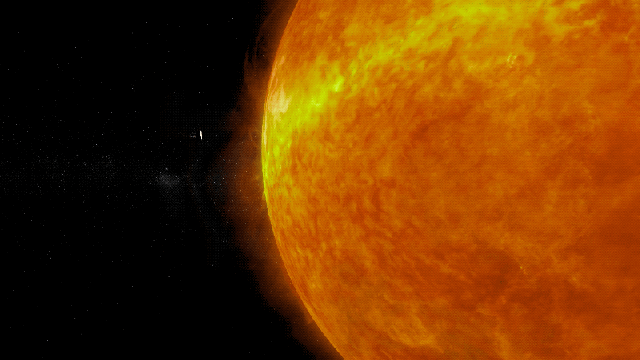NASA’s daring mission to kiss the Sun is now into its 15th month, with the Parker Solar Probe steadily drawing closer to our host star with each passing orbit. Data gathered by the probe during its first two stellar flybys is now available online, with NASA making it “available for interested public users to manipulate, analyse, and plot in any way they choose.”
Since entering into space on August 12, 2018, the Parker Solar Probe has completed three solar orbits. Data collected during the first two orbits is now publicly accessible, according to NASA. The trove—posted online this past Tuesday—consists of raw data files and graphical displays.
[referenced url=” thumb=” title=” excerpt=”]
This is awesome, because the Parker Solar Probe is going where no spacecraft has gone before, and it’s accumulating unprecedented types of information. The probe has already set the record for the closest approach to the Sun by a human-built object, and it’s also the fastest spacecraft ever sent into space. Of scientific importance, the probe is making measurements from within and around the corona—the immediate stellar environment around the Sun. This data, whether crunched by elite researchers or citizen scientists, could tell us more about the Sun and how it works, as well as improve our ability to predict severe space weather, such as damaging solar storms.
“Releasing this data to the public will allow them not only to contribute to the success of the mission along with the scientific community, but also to raise the opportunity for new discoveries to the next level,” said Nour Raouafi, a Parker Probe project scientist, in a NASA press release.
Parker’s array of specialised onboard instruments are measuring the characteristics of the solar wind. The uploaded data can be accessed through several websites: the NASA Space Physics Data Facility, the Solar Data Analysis Centre, the APL Parker Solar Probe Gateway.
The data includes measurements made by the probe from October 31, 2018 to November 12, 2018, and March 30, 2019 to April 19, 2019. This data includes measurements made during both perihelion and aphelion, when the probe was at its closest and farthest points from the Sun along its orbital path. During its first and second perihelion, for example, the spacecraft got as close as 24.8 million kilometers (15.41 million miles) from the Sun. Mercury, the closest planet to the Sun, gets as close to 46 million kilometers to the Sun at its perihelion.
So that’s three solar orbits down, 21 to go. The fourth perihelion is expected on January 29, 2020, at which point the probe will come to within 19.4 million kilometers (12.05 million miles) of the Sun, while reaching speeds in excess of 109 kilometers per second (67.6 miles per second).
Eventually, the Parker Solar Probe will get to 6.4 million kilometers (4 million miles) from the Sun, at which point it’ll have to endure tremendous amounts of heat and radiation. This will happen in 2025, and as we’d expect from a mission like this, the probe will continue to gather data right up until it’s burnt to a metallic crisp.
